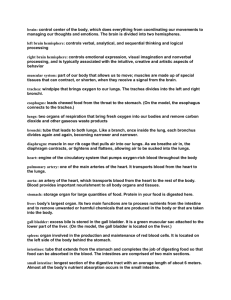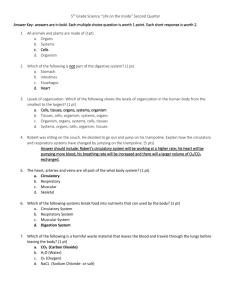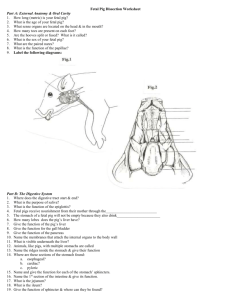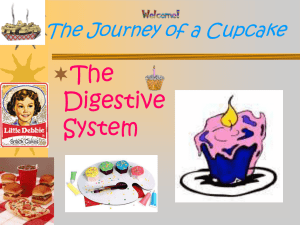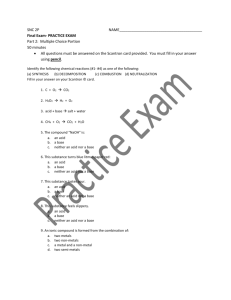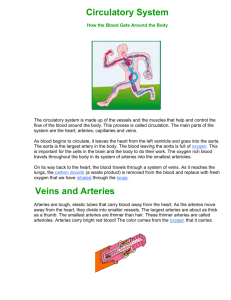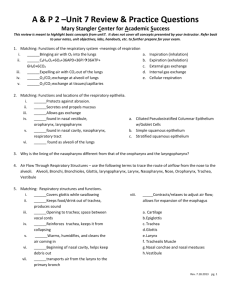5th Grade Chapter 3 Notes Continued
advertisement
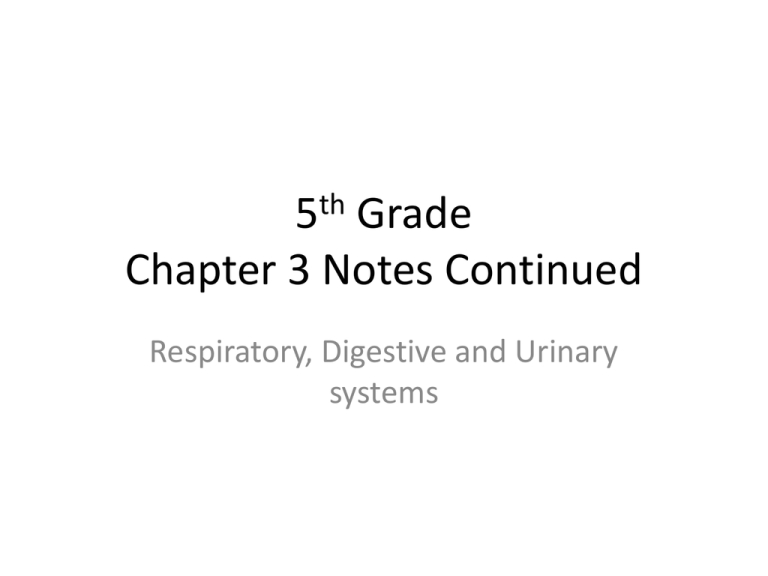
5th Grade Chapter 3 Notes Continued Respiratory, Digestive and Urinary systems Respiratory System Mucus • ____________ is a sticky, thick fluid that traps dust, germs, and other things that may be in the air. • 1. Air enters through the _______or ________. nose mouth • 2. __________warm and moisten the air. Sinuses • 3. With its hairs and layer of ________, the nose Mucus traps dust and germs. • 4. Air passes from the sinus to the back of the throat and into the _________. Larynx Vocal Cords • 5. The larynx contains the ______________. How Air Travels into and Through your Body Continued • 6. Trachea ___________ is a tube that carries air from the larynx to the lungs. • 7. The trachea leads to two branches called Bronchi Lungs ___________that go into the _______. • 8. In the lungs, these tubes branch into bronchioles smaller and smaller tubes called__________. Asthma ___________is a disease in which these tubes may become narrowed. This prevents air from easily traveling through the lungs. How Air Travels into and Through your Body Continued • 9. The bronchioles end in clusters of tiny thinwalled pouches or ________ in the lungs Air sacs oxygen enters the blood and carbon dioxide leaves the blood. Air sacs are also called alveoli _______. diaphragm • 10. The _________is a dome-shaped muscle that forms the bottom of the chest area muscle _________it moves _______ and gets muscle down flatter _______. Cilia • _______are tiny, hairlike Cilia structures on cells in the linings of many parts of the respiratory system, such as the trachea. - Cilia help clean air by waving __________ very rapidly - pushes dirty __________ out of the _________ mucuc Lungs to the _________, where it is Throat swallowed. Respiratory and Circulatory Systems Working Together • Respiratory and circulatory systems work oxygen to the cells. together to get ________ • The respiratory system gets the oxygen to tiny Air sacs inside your ______. lungs ________ • The _______picks up the oxygen there and blood cells carries it to all your _____. • In the _______: Air sacs – __________ leaves the lungs and enters the blood. oxygen Carbon dioxide leaves the blood and enters the – _______________ lungs. Output / Input • Output of one system is the input of the other system. • Several systems working together to make sure your cells get oxygen - EXAMPLE Carbon dioxide When you hold your breath, ____________ brain builds up in your blood. Your _______ can sense this. Your brain sends a message to the ____________ and rib _________ telling them diaphragm muscles to _________.. breathe Digestive System changed • Food has to be ___________ before your cells can use it - broken down into very small materials. blood • Then the food can enter the __________ to get to your ________. cells organs • Digestion takes many ________ working together. Each organ has __________ that structures help it do its part of the job. Mouth and Esophagus chewing • _____________ is the first step of digestion makes food small enough to swallow, and it makes the job of the rest of the digestive system easier. esophagus • The ____________ is a tube that carries food to the stomach - pushes food to the stomach by muscles squeezing its rings of __________ in a pattern. • Food travels through the esophagus to the stomach in about two or three ___________. seconds Stomach • ___________ stomach - At the bottom of your esophagus - a tight round muscle. • When you swallow, this muscle relaxes and opens to let food into your stomach. Then the muscle closes to keep the food from moving back into your esophagus. stretch to store all the food from a • Stomach's walls can _______ meal. • The stomach produces ________ fluids that help to digest foods. squeeze • As strong muscles in the stomach's walls __________, these fluids mix with the food. • After the food becomes a soupy _________, it is ready to paste leave your stomach. Intestines • The stomach squeezes the partly digested food into a Small Intestine narrow, winding tube called the _____________ Liver pancreas • __________ and _____________are organs that send chemicals to your small intestine to help digest food. • When digestion is finished, the particles of digested food can move into ________________ that are in the Blood vessels walls of your intestine. • Tiny finger-shaped structures called _________are villi found all over the inside walls of the small intestine. Surface area • Villi give the small intestine more ______________ to absorb food. Large Intestine • At the end of the ________________, some food Small intestine that cannot be digested remains. • This food waste moves to a wider tube called the Large intestine - also known as the ______. colon ______________ Helpful bacteria live here. water • The large intestine takes _________ and _______from the wastes making the waste more salts solid. • Finally, muscles squeeze to push the ________ waste out of the body. Urinary System • ___________________ - rid the body of wastes that are in Urinary system the blood. • ______________ are a pair of organs that remove wastes kidneys from your blood. They are on either side of your ____________, just under your lowest ribs. backbone • When wastes are filtered out of the blood, many other materials also leave the blood - water, salt, calcium, nutrients, and other chemicals your body needs. • The ____________ has to put the right amount of these kidney materials back into the blood to keep the body healthy. • Kidneys help keep the amounts of these materials from regulates getting too high or too low - ____________ Urine • Mix of wastes and water is urine ___________. • A tube _________ carries urine away from the kidneys to the _______________. Urinary bladder bladder • ____________stores urine until it leaves the body. • The kidneys are not the only organs that get rid of cells’ wastes. – _______________ Carbon dioxide is a waste product removed by the lungs. – ______________Sweat Glands also release a small amount of cells’ wastes in sweat.
